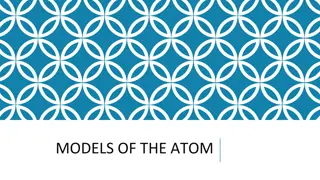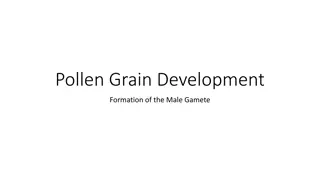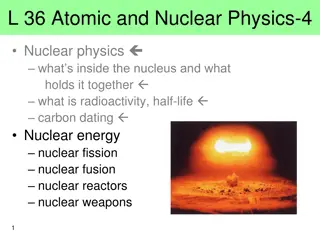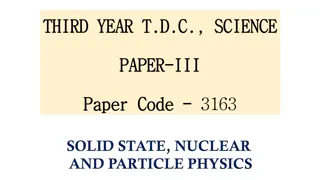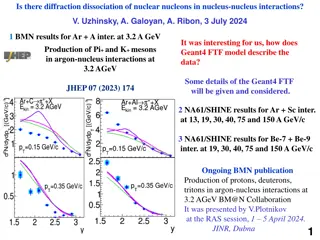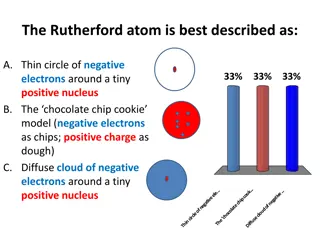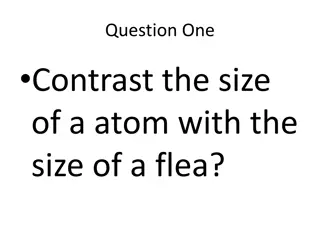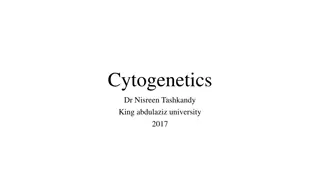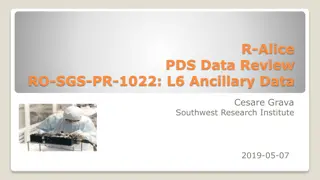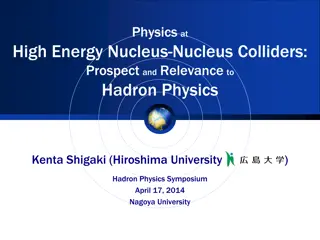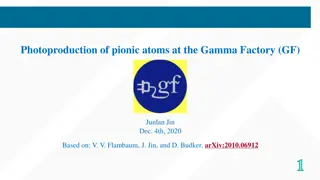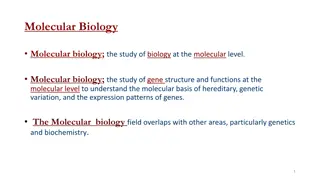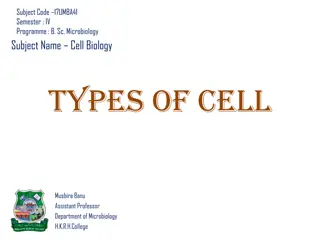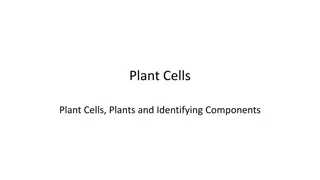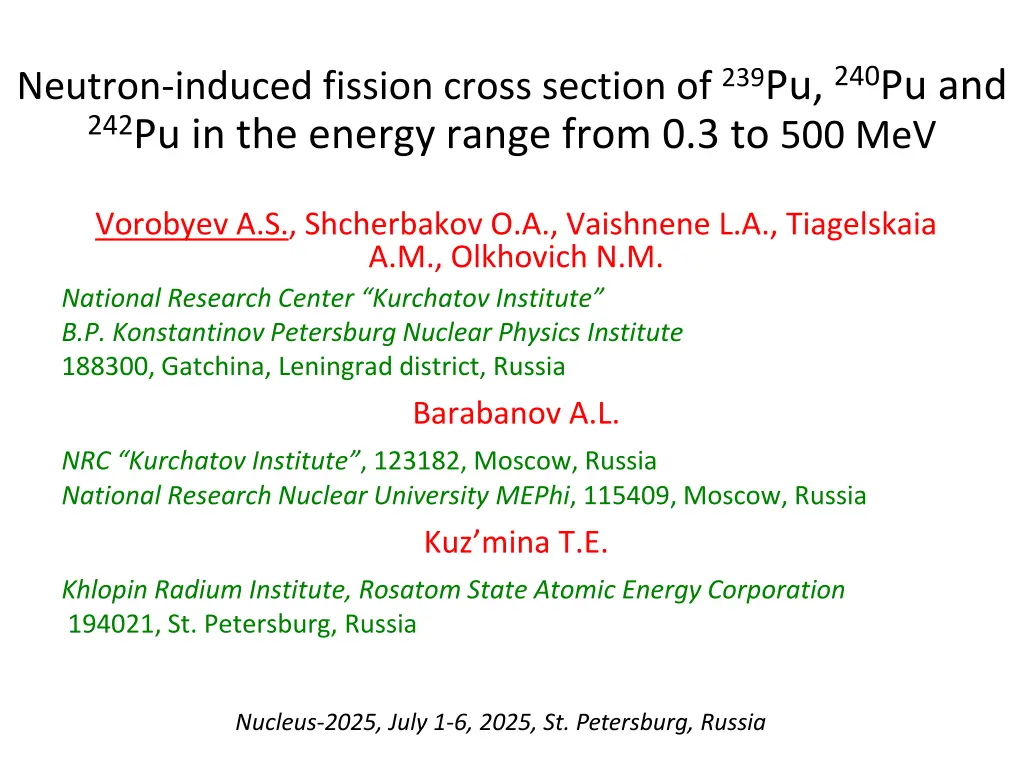
Neutron-Induced Fission Cross Section Study of Pu Isotopes
Explore the neutron-induced fission cross section of Pu isotopes (239Pu, 240Pu, and 242Pu) in the energy range of 0.3 to 500 MeV. This research, conducted at NRC Kurchatov Institute, aims to enhance understanding of fission processes for advanced nuclear technologies. Data on angular distributions and cross sections provide valuable insights for modeling fission processes across different energy ranges. Experimental setups and theoretical approaches based on the Hauser-Feshbach model are discussed, highlighting the significance of analyzing fission barriers and pre-equilibrium processes. The development of a neutron time-of-flight spectrometer (GNEIS) for measuring neutron flux and energy is also described.
Download Presentation

Please find below an Image/Link to download the presentation.
The content on the website is provided AS IS for your information and personal use only. It may not be sold, licensed, or shared on other websites without obtaining consent from the author. If you encounter any issues during the download, it is possible that the publisher has removed the file from their server.
You are allowed to download the files provided on this website for personal or commercial use, subject to the condition that they are used lawfully. All files are the property of their respective owners.
The content on the website is provided AS IS for your information and personal use only. It may not be sold, licensed, or shared on other websites without obtaining consent from the author.
E N D
Presentation Transcript
Neutron-induced fission cross section of 239Pu, 240Pu and 242Pu in the energy range from 0.3 to 500 MeV Vorobyev A.S., Shcherbakov O.A., Vaishnene L.A., Tiagelskaia A.M., Olkhovich N.M. National Research Center Kurchatov Institute B.P. Konstantinov Petersburg Nuclear Physics Institute 188300, Gatchina, Leningrad district, Russia Barabanov A.L. NRC Kurchatov Institute , 123182, Moscow, Russia National Research Nuclear University MEPhi, 115409, Moscow, Russia Kuz mina T.E. Khlopin Radium Institute, Rosatom State Atomic Energy Corporation 194021, St. Petersburg, Russia Nucleus-2025, July 1-6, 2025, St. Petersburg, Russia
Motivation A few years ago at the NRC "Kurchatov Institute -PNPI the research program of the fission process in the intermediate neutron energy range 1-200 MeV was started, aimed at obtaining new information about the angular distribution of the fission fragments and the fission cross section. These data are of prime importance for the advanced nuclear technologies such as Accelerator-Driven Systems (for nuclear power generation and nuclear transmutation). Also the information about angular distribution of fission fragment is very important to verify parameters of models using for adequate fission process description in neutron energy range above 20 MeV. The data about fission fragment anisotropy are very scarce in neutron energy range above 20 MeV and are practically absent for neutron energy range above 100 MeV. In the first stage of this research, the fission fragment angular distributions have been measured for232Th, 233U, 235U, 238U, 239Pu,240Pu, 237Np, natPb and 209Bi nuclei using the same data processing and position sensitive multiwire proportional counters for fission fragment registration. 2 Nucleus-2025, July 1-6, 2025, St. Petersburg, Russia
Motivation In order to describe the obtained data, the theoretical approach based on the Hauser-Feshbach model has been developed that would allow to calculate the angular distributions of the fragments in a wide range of excitation energies using the Talys 1.9 code (more details in Barabanov s presentation at this conference). During this calculation it was found that the joint analysis of the fission cross section and the angular distributions of the fragments provides new details about fission barriers, nucleus characteristics at barriers, transition state energies, and the role of pre-equilibrium processes in the interaction of nuclei with neutrons. In the second stage, the experimental setup has been modernized so that simultaneous measurements of fission distributions of fission fragments can be performed. In a new setup the measurements were performed for236U, 238U, 237Np, 239Pu, 240Pu, 242Pu and 243Am nuclei. Recently, the results have been presented for236U, 238U,242Pu and 243Am. In this work the result for239Pu,240Pu and242Pu are presented as well as the experimental setup. cross sections and angular 3 Nucleus-2025, July 1-6, 2025, St. Petersburg, Russia
Neutron time-of-flight spectrometer GNEIS GNEIS building beam stops IC monitor MWPCs chamber beam tube collimators PM start detector Neutron spectrum of GNEIS: from thermal to 1GeV concrete shielding of the accelerator Neutron flux, n/cm2 s MeV neutron shutters collimators evaporation component A 0.5 mm thick Cd filter was used to remove neutrons from the beam. beam tubes recycled vacuum magnet fast neutrons beam cascade component cyclotron proton beam actuators for target and moderator Pb target Neutron energy, MeV Main parameters: ? ? 1 ??? 1% ; ? 200 ??? 12% ????????= 1 GeV; Lead target; ? 10 ns; ? 50 Hz; ?~3 1014n ? s; ? = 36.5 m 4 Nucleus-2025, July 1-6, 2025, St. Petersburg, Russia
Experimental set-up and data acquisition system (Schematic view) The fission cross section for each of the investigated nuclei was measured relative to the235U(n, f) cross section during the same measuring session. The same235U target is used for all measurements. Measurements were made for two orientations relative to the direction of neutron beam, so that the fluence was approximately the same for these orientations. Waveforms from the anodes and cathode of each MWPC and from FIC monitor, as well as a signal from the PMT-Start detector re recorded with two 500 MHz 8 bit digitizers. The digitizers were synchronously triggered by a signal from the PMT - START detector that registers quanta and neutrons emitted from the lead neutron production target. PC personal computer; MWPC the position sensitive low pressure multiwire proportional counter 140 140 mm2of size PMT START detector (generate a trigger signal for a data acquisition system every time the protons hits a lead target of the GNEIS TOF-spectrometer); FIC the fission ionization chamber with238U targets for relative monitoring of the neutron flux; PA preamplifier; HV1, HV2, HV and HV FIC high voltage sources; X1, X2 anodes of the MWPCs 1, 2 (x coordinates); Y1, Y2 anodes of the MWPCs 1, 2 (y coordinates); C1, C2 the cathodes of the MWPCs 1, 2 239Pu 237Np 5 Nucleus-2025, July 1-6, 2025, St. Petersburg, Russia
Results: Separation of events registered in one measurement session corresponding to the fission of 235U and investigated nuclei Schematic view of the assembly of two MWPCs TOF spectrum of FFs at various angles T1 ~27 T2 242Pu (T1-T2) 242Pu The cosine of the angle between the fission axis and the normal to the MWPCs plane calculated by : Time stamps T1 and T2 are derived from the waveforms of the signals from the two cathodes. If the time stamp T1 is earlier than T2, it means that fission fragment flew from MWPC1 to MWPC2 from investigeted nuclei, if it is later from235U. d = cos( ) + + 2 2 2 ( 1 ) 2 x ( 1 ) 2 y x y d where d is the distance between cathodes C1 and C2; x1, x2 are the x-coordinates of the detected particle at the anodes X1 and X2; y1, y2 are the y-coordinates of the detected particle at the anodes Y1 and Y2. The events from investigated nucleus and235U were separated using the fission fragment time-of-flight spectrum (T1-T2). A very good separation was observed. 6 Nucleus-2025, July 1-6, 2025, St. Petersburg, Russia
Results: fission fragment separation method for example - the 240Pu case Before separation After separation The used method of separation of fission fragment events from events corresponding other background reactions lets to obtain practically ideal separation without decreasing the efficiency of registration of fission fragments. 7 Nucleus-2025, July 1-6, 2025, St. Petersburg, Russia
Results: anisotropy of angular distributions of fission fragments (fitting the measured angular distributions by Legendre polynomials) for example -242Pu case The anisotropy of the angular distribution of fission fragments for investigated nuclei is determined using the coefficients A2and A4for the corresponding Legendre polynomials. 8 Nucleus-2025, July 1-6, 2025, St. Petersburg, Russia
Results: anisotropy of angular distributions of fission fragments The solid lines are drawn only for visualization of experimental data obtained in this work. In the neutron energy range below 20 MeV, our results agree within experimental uncertainties with the most full data sets. There are only present results above 20 MeV. At the present, the theoretical description of the observed dependences of the anisotropy of fission fragments on the neutron energy has been performed only for240Pu (more details in Barabanov s presentation at this conference). 9 Nucleus-2025, July 1-6, 2025, St. Petersburg, Russia
Results: the absolute ratio of the neutron-induced fission cross sections of 239,240,242Pu and 235U (TOF-measurements) For presented work only statistical errors are shown. The reported systematic errors are 1-4%. There is a general agreement in the shape of the ratios for240Pu and242Pu, but not for239Pu, for which a discrepancy of around 10% is observed in the energy range above 10 MeV. The evaluated data from JENDL-5 and ENDF/B- VIII.0 appear to exceed the TOF experimental data in the 1 - 5 MeV energy range. N (upper index) mark the ratio shape measurement 10 Nucleus-2025, July 1-6, 2025, St. Petersburg, Russia
Results: the absolute ratio of the neutron-induced fission cross sections of 239,240,242Pu and 235U (measurements in separate energy points) For presented work only statistical errors are shown. The reported systematic errors are 1-3%. There is a general agreement between our results and those obtained using electrostatic accelerators within total uncertainties. The evaluated data from JENDL-5 and ENDF/B- VIII.0 for239Pu agree with the experimental data in the 1 - 5 MeV energy range, while for240Pu and242Pu they appear to exceed ones. N (upper index) mark the ratio shape measurement 11 Nucleus-2025, July 1-6, 2025, St. Petersburg, Russia
Results: the neutron-induced fission cross sections of 240Pu The neutron-induced fission cross sections of investigated nuclei were determined as the product of the measured ratio and the IAEA standard the 235U(n,f) cross section (Nucl. Data Sheets 148, 143 (2018)). For presented work the total errors are shown. It is seen that the240Pu(n,f) cross section obtained in the present work is consistent with the results taken from EXFOR except for the data of Weston et al., which deviate from the other data by more than the stated uncertainty (0.7%). The evaluated data from JENDL-5 and ENDF/B-VIII.0 appear to exceed the experimental data in the 1 - 5 MeV energy range. 12 Nucleus-2025, July 1-6, 2025, St. Petersburg, Russia
Results: the neutron-induced fission cross sections of 242Pu For presented work the total errors are shown. It is seen that the242Pu(n,f) cross section obtained in the present work is in a general agreement with the results of other works taken from EXFOR, within total uncertainties. The shape of the fission cross section obtained by the recent experiments is different. The evaluated data from JENDL-5 and ENDF/B-VIII.0 appear to exceed about 3-4% the experimental data in the 2 - 5 MeV energy range. 13 Nucleus-2025, July 1-6, 2025, St. Petersburg, Russia
Results: the neutron-induced fission cross sections of 239Pu The fission cross section of 239Pu(n,f) is of particular interest since it is recommended as a standard. The errors shown in the figure below are total The errors shown in the figure below are statistical The present result is consistent with the absolute measurements of the fission cross section within uncertainties, with exception of Merla and Li Jingwen data, which are ~5-7% higher. The result of the last239Pu(n,f)/235U(n,f) cross section ratio measurement (Snyder 2021) is ~2.5% higher than Tovesson+ s and our data, but the shape agreement is very good. For neutron energies below 15 , the shape of the recommended fission cross section of 239Pu(n,f) agrees with the latest experimental data, whereas there is a noticeable difference (up to ~4%) in the energy range from 15 to 150 MeV. The239Pu standard needs to be revised. 14 Nucleus-2025, July 1-6, 2025, St. Petersburg, Russia
Conclusions Measurements of the neutron-induced fission cross sections of239Pu,240Pu and242Pu were carried out on the neutron TOF-spectrometer GNEIS at Petersburg Nuclear Physics Institute of National Research Centre Kurchatov Institute in the energy range up to 500 MeV. The cross sections of239Pu(n, f),240Pu(n, f) and242Pu(n, f) were measured relative to the cross section of235U(n, f), which is an accepted international standard. The total uncertainty of the data obtained is 3-4%. The shape of the fission cross section energy dependence obtained in this work is mostly consistent with the results of all previous data obtained in the TOF experiments. There are some deviations of the estimated data from experimental data. For 239Pu(n,f), which recommended as a standard, this deviation reaches about 3% in energy range from 15 MeV to 150 MeV, for240Pu(n,f) and242Pu(n,f) in the 1 5 MeV energy region (important for ADS systems) - ~1-2% and 3-4%, respectively. Therefore, the further experimental and evaluation researches are needed. 239Pu, 240Pu and 242Pu fission fragments were Also the angular distributions of measured in the investigated neutron energy range. For neutron energy range above ~10 MeV the anisotropy of the fission fragments have been obtained for the first time. Nucleus-2025, July 1-6, 2025, St. Petersburg, Russia 15
Experimental set-up and data acquisition system (Targets) Targets from239,240,242Pu and235U were fabricated at the Khlopin Radium Institute (St. Petersburg) by the painting method on aluminum substrates 0.1 mm in thickness. The initial shapes and sizes of the active layer were different (50 100 mm for235U and 82 mm for237Np). To measurements namely, small wide homogeneous neutron beam, 0.1-mm- thick aluminum masks were placed on the active layers of the both targets to separate equal circular regions with a diameter of 48 mm on the active layers. The number of nuclei in active spots of masked targets (NPu/NU5) was determined by counting -activity in a well-defined geometry using a surface barrier detectors (more details in Olkhovich s poster at this conference). ensure identical of and equal shape samples in conditions cross for 235U 239Pu 240Pu 242Pu fission sections, Isotope Mass percentage (%) 234U 0.0020 235U 99.9920 236U 0.0040 238U 0.0020 238Pu 0.063 0.0013 239Pu 99.764 0.6146 0.254 240Pu 0.167 99.1322 0.092 241Pu 0.003 0.1928 239Pu 240Pu 242Pu 242Pu 0.003 0.0604 99.647 (NPu/NU5) 1.352(19) 0.839(13) 1.485(29) 241Am <0.006 0.0054 17 Nucleus-2025, July 1-6, 2025, St. Petersburg, Russia
Admixture of spontaneous fission In addition to the -decay mode, the240Pu (T1/2= 6561(7) y) and242Pu (T1/2= 3.73(2)x105y) nucleus also has a spontaneous fission decay mode with a probability 5.7(2) 10-8and 5.53(5) 10-6. This creates a non-correlated background of spontaneous fission events. It was calculated based on the efficiency of detection of fission fragments, the spontaneous fission half-life, and the mass of isotope in ``masked'' target precisely determined in this work. Since there are more spontaneous fission events in the case of242Pu, for example, the242Pu(SF) yield is shown in figure. 18 Nucleus-2025, July 1-6, 2025, St. Petersburg, Russia
Typical uncertainties of the fission cross section ratio measured (for example 242Pu(n,f)) So we have determined the scaling factor NPu/NU5- the ratio of the number of242Pu(239Pu or240Pu) and235U nuclei in the targets. Both of these targets were placed in a wide and uniform neutron flux, and fission fragments were registered by the same pair of the detectors with the same efficiency. Corrections were applied: for the geometrical efficiency dependence on angular anisotropy of fragment emission, for the isotopic composition of the targets, and for the background from spontaneous fission events. 60 3 % (0.1-0.6 MeV) 2 3 % (above 0.6 MeV) <0.3 % ~0.6 % <0.02 % (above 1.0 MeV) Statistical uncertainties Attenuation of the neutron flux Anisotropy Spontaneous fission Purity of targets (isotope composition) Efficiency of MWPCs (geometrical uncertainty) Scaling factor (N m3/NU5) Total error Uncertainty of the 235U standard cross section (Carlson et al., Nuclear Data Sheets 148, 143, 2018) The measurement error is ~2.2% and it is mainly determined uncertainty of the scaling factor determination ~2.0%. total average systematic 0.1 % (above 1.0 MeV) by the 0.3 % 2.0 % ~3.7 % 1.3 1.5 % (below 20 MeV) 1.5 4.8 % 20 200 MeV 5 7 % (above 200 MeV) f(235U) 19 Nucleus-2025, July 1-6, 2025, St. Petersburg, Russia
Results: Monte-Carlo simulation of real geometry The efficiency of FF registration was calculated taking into account following parameters: the electrode wire structure, distances between MWPCs and target, sizes of electrodes and distances between them, sizes of the target and neutron beam, the position (angular) resolution. The total efficiency is ~ 45%. 20 Nucleus-2025, July 1-6, 2025, St. Petersburg, Russia

